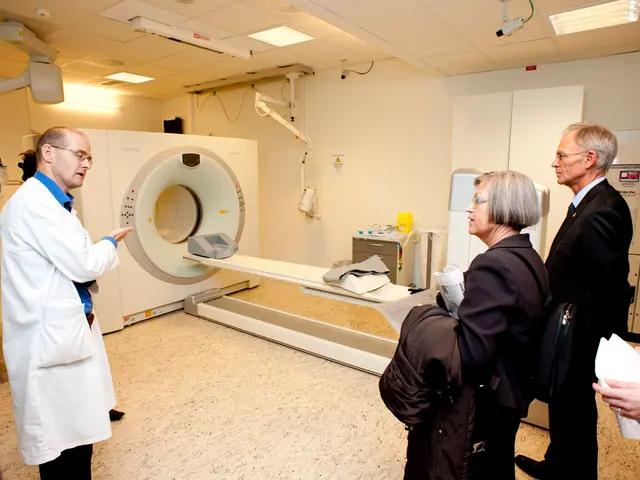Minamata Disaster's Impact: An Examination of its Consequences
The Minamata disease outbreak, a major case of industrial mercury poisoning, unfolded in Japan between 1932 and 1968. This devastating event, first recognised in 1956, was caused by the discharge of methylmercury into Minamata Bay from a factory owned by the Chisso Corporation [2][4].
During the 36-year disaster period, the Chisso Corporation released mercury compounds into Minamata Bay, causing widespread poisoning [2]. The poisoning was traced to methylmercury contamination of fish and shellfish in the bay, which local residents consumed, leading to severe deformities, neurological symptoms, and death in thousands of people [2].
The root cause of the disaster was industrial pollution, specifically mercury compounds discharged by the Chisso Corporation from its fertilizer and later petrochemical manufacturing processes into the water system [2]. Methylmercury bioaccumulated in marine life, entering the human food chain and causing severe toxic effects when consumed by local populations [2][4].
Over 3,000 people suffered severe symptoms or death; many survived with chronic neurological disabilities [2]. The disaster raised awareness about environmental pollution and industrial negligence in Japan and globally. It influenced environmentalism movements and regulations to prevent similar contamination events [4].
The social impact included prolonged struggles for recognition and compensation for victims, extensive medical research into mercury poisoning, and the establishment of the Minamata Disease Museum to preserve awareness [5].
The Minamata disease outbreak remains one of the starkest examples of industrial pollution’s devastating impact on human health and the environment, contributing significantly to environmental and public health policies in Japan and beyond [2][4]. As of 2019, there were 2,282 cases of Minamata disease with official recognition, but many more cases are likely to have gone without recognition.
Decades of restoration efforts by the United Nations Environment Programme (UNEP) have been made, but the methylmercury poisoning event continues to affect people in Minamata Bay. In response, the United Nations established the Minamata Convention on Mercury in 2013, an international treaty to protect people from exposure to mercury and mercury compounds [6].
The Minamata Convention on Mercury includes measures such as controlling the supply and trade of mercury, limiting mercury sources, and controlling mercury-added products. The event resulted from the industrial release of mercury compounds into the local water, compromising the local food supply. Some symptoms of Minamata disease are curable, but symptoms that result from neurological implications are not reversible [3].
Research suggests that fetuses started developing Minamata disease while still in the uterus, and babies were born with conditions resembling cerebral palsy as a result of methylmercury poisoning. The original case of Minamata disease received official recognition in 1968, four months after the factory stopped producing mercury compounds, and this was 12 years after the start of the epidemic [1].
Human activities have caused mercury levels to rise by approximately 450% over their natural levels. Monitoring of mercury and mercury-component poisoning has improved since the start of the Minamata Convention on Mercury. The main treatment for methylmercury poisoning includes supportive therapy, decontamination, and removal from the source, but the neurological effects are often irreversible [3].
The onset of symptoms was often sudden, and people who developed difficulty hearing, seeing, and swallowing deteriorated particularly quickly. The original case of Minamata disease gained recognition in May 1956, after industrial mercury pollution caused health damage in Minamata Bay, Japan [1].
References:
[1] Minamata disease. (2019). In Encyclopædia Britannica. https://www.britannica.com/topic/Minamata-disease
[2] Minamata disease. (n.d.). In World Health Organization. https://www.who.int/news-room/fact-sheets/detail/minamata-disease
[3] Minamata disease. (n.d.). In Mayo Clinic. https://www.mayoclinic.org/diseases-conditions/minamata-disease/symptoms-causes/syc-20377310
[4] Minamata disease. (n.d.). In United States Environmental Protection Agency. https://www.epa.gov/mercury/minamata-disease
[5] Minamata disease. (n.d.). In Japan Guide. https://www.japan-guide.com/e/e2074.html
[6] Minamata Convention on Mercury. (n.d.). In United Nations Environment Programme. https://www.mercuryconvention.org/About/TheConvention/tabid/3288/Default.aspx
- The Minamata disease outbreak, a severe example of industrial mercury poisoning, highlighted the connection between environmental pollution, public health, and neurological disorders.
- This tragic event, which unfolded in Japan between 1932 and 1968, introduced the global community to the devastating consequences of industrial negligence and the impact of climate change on health-and-wellness, as well as mental-health.
- Survivors of the disaster, who numbered over 3,000, were left with chronic neurological disabilities and other medical-conditions as a result of the poisoning.
- Research from the environmental-science community has revealed that mercury levels have risen dramatically due to human activities, posing a significant risk to the environment and sustainability.
- In response to this tragic incident, the United Nations established the Minamata Convention on Mercury in 2013, a treaty designed to protect people from exposure to mercury and mercury compounds, address pollution, and promote sustainability worldwide.



